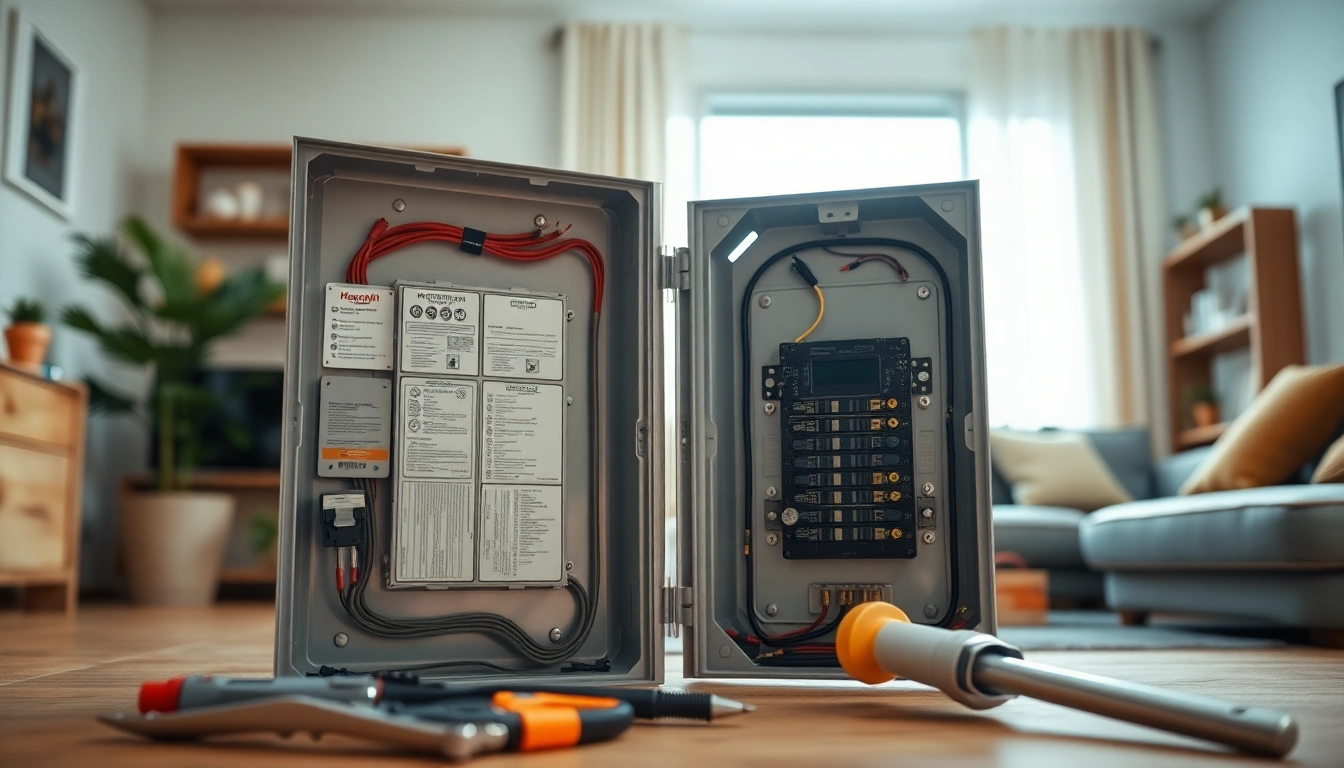Understanding Home Remodeling: Key Concepts
Embarking on a home remodeling project can be an exciting yet daunting endeavor. Whether you are looking to modernize your kitchen, improve your bathroom, or create more open spaces, understanding the fundamentals of home remodeling is crucial. This guide will explore what remodeling entails, reasons to undertake a remodeling project, and the basic steps to initiate your project.
Defining Home Remodeling vs. Renovating
While the terms “remodeling” and “renovating” are often used interchangeably, they signify different processes in the realm of home improvement. Remodeling refers to altering the structure, layout, or function of a home. For instance, converting a garage into a living space is considered remodeling as it changes the original usage of that area.
On the other hand, renovation typically involves restoring or upgrading a space without significant changes to its structure. Painting walls, replacing fixtures, or refurbishing existing cabinets fall under renovation. Understanding this distinction is essential as it influences budgeting, planning, and execution strategies for any home improvement project.
Common Reasons for Home Remodeling
People choose to remodel their homes for various reasons. Here are some common motivations:
- Increasing home value: Remodeling can significantly enhance a property’s value, making it appealing to potential buyers.
- Personalization: Homeowners often want to tailor spaces to reflect their lifestyles and preferences.
- Necessary repairs: Aging infrastructure or damage from natural disasters often necessitates remodeling to restore functionality.
- Modernization: Keeping up with current trends (like eco-friendly options or smart home technologies) may drive the desire to remodel.
Basic Steps to Initiate Your Project
Starting a remodeling project requires careful planning and execution. Below are essential steps to get you started:
- Define Your Goals: Clearly outline what you hope to achieve with your remodel, whether it’s aesthetic changes, increased functionality, or both.
- Set a Budget: Determine how much you are willing to spend on the project, keeping additional costs in mind.
- Research: Explore various remodeling ideas through online resources, magazines, or by visiting showrooms.
- Consult Professionals: Depending on the scope of your project, you may need to hire a contractor, designer, or architect.
- Timeline Preparation: Create a timeline for your project that includes planning, execution, and potential delays.
Planning Your Home Remodeling Project
Budgeting for Your Home Remodeling
Budgeting is one of the most critical aspects of planning a successful remodeling project. A well-structured budget should consider the following:
- Project Scope: Understand the extent of your remodeling. Will you do minor upgrades, or does it require major structural changes?
- Material Costs: Research the costs of materials, labor, and any additional services you will need.
- Contingency Funds: Set aside at least 10-20% of your budget for unexpected expenses that may arise during the remodeling process.
- Financing Options: Explore various financing avenues, including home equity loans, personal loans, or credit cards.
Selecting the Right Contractors
Choosing the right contractor can make or break your remodeling project. Here are strategies to select a reliable professional:
- Research: Look for contractors with strong reputations, check online reviews, and ask for recommendations from trusted friends.
- Qualifications: Confirm that your contractor holds the necessary licensing and insurance.
- Portfolio: Review previous work to ensure that their style aligns with your vision.
- Get Multiple Quotes: Obtain at least three quotes to compare services, costs, and estimated timelines.
- Contract Terms: Be sure to read the contract carefully—pay attention to details regarding payment schedules, timelines, and warranties.
Design Considerations: Style and Functionality
When planning your remodeling project, balancing style with functionality is essential. Consider the following:
- Consistency: Ensure that the design harmonizes with the existing architecture and style of your home.
- Space Efficiency: Focus on optimizing available space rather than merely expanding it.
- Comfort: Beyond aesthetics, think about how the changes will affect everyday living—can you easily access crucial areas or appliances?
- Trends vs. Timelessness: While it’s enticing to follow the latest trends, select designs that will remain appealing long-term.
Popular Home Remodeling Ideas to Consider
Kitchen Remodeling Trends
The kitchen is often considered the heart of the home, making it a popular area for remodeling. Current trends include:
- Open Concept Layouts: Connecting the kitchen to other living spaces to create a more inclusive environment.
- Energy-Efficient Appliances: Integrating modern, energy-efficient appliances that reduce utility costs.
- Smart Technology: Incorporating tech features such as smart fridges, programmable thermostats, and lighting systems.
- Natural Materials: Using sustainable materials like bamboo, reclaimed wood, or recycled glass for countertops and cabinets.
Bathroom Upgrades that Increase Value
Bathrooms are pivotal in adding value to a home. While planning a bathroom remodel, consider these updates:
- Dual Sinks: Adding dual sinks enhances convenience, particularly for families.
- Walk-in Showers: Upgrading to a walk-in shower can create a luxurious feel and improve safety.
- Quality Fixtures: High-quality fixtures not only enhance appearance but also durability.
- Eco-Friendly Options: Implementing water-efficient toilets and faucets reduces overall water consumption.
Creating Open Floor Plans: Pros and Cons
Open floor plans are trending in modern homes, promoting spaciousness and accessibility. Here are the advantages and disadvantages:
Pros:
- Enhanced light and air circulation throughout the space.
- Greater flexibility in furniture arrangements and functionality.
- Encourages social interaction, especially during gatherings.
Cons:
- Lack of privacy for designated spaces, which can be challenging for larger families.
- Noise can travel freely throughout the space, potentially disrupting the home’s peace.
- Heating and cooling can be more complex and expensive due to the larger combined area.
Executing Your Home Remodeling Plan
Project Management Tips
Effective project management is vital to steering your home remodeling project to completion. Here are some tips to stay on course:
- Regular Communication: Maintain open lines of communication with your contractor to address concerns as they arise.
- Scheduling: Stick to the original timeline but remain adaptable to unforeseen circumstances.
- Documentation: Keep detailed records of correspondence, contracts, and receipts for easy reference.
- Site Visits: Visit the site regularly to monitor progress and ensure that the work meets your expectations.
Permits and Regulations You Must Know
Depending on the scope of your remodeling project, specific permits may be needed. Here are some guidelines to navigate this aspect:
- Identify Requirements: Research any permit requirements specific to your city or county, as regulations can vary.
- Schedule Inspections: Some projects may require in-progress inspections by local authorities to ensure safety standards are met.
- Building Codes: Ensure all work complies with local building codes to avoid disputes or fines.
Dealing with Unexpected Issues
Despite thorough planning, unforeseen challenges can arise during a remodeling project. Here are some common issues and solutions:
- Budget Overruns: When costs exceed the budget, reassess your priorities—consider downgrading materials or scaling back your project scope.
- Delays: Weather issues or supply chain delays may occur. Build some flexibility into your timeline to accommodate these setbacks.
- Design Changes: Mid-project design changes can be costly. Attempt to finalize your design before work begins to minimize disruptions.
Maximizing Results After Your Home Remodeling
Final Touches: Decor and Furnishings
The final touches can significantly impact the atmosphere of a newly remodeled space. Here are several suggestions:
- Color Schemes: Choose a cohesive color palette that complements your design themes while expressing your personal style.
- Functional Furniture: Select furnishings that enhance usability—like multi-functional pieces that can adapt to different settings.
- Art and Accessories: Incorporate art pieces and accessories that resonate with your personality while also enhancing aesthetic appeal.
Maintaining Your Newly Remodeled Space
Once your remodeling project is complete, maintenance is key to preserving its beauty and functionality:
- Routine Cleaning: Establish a cleaning routine tailored to the specific materials used in your remodel.
- Regular Inspections: Periodically inspect for any signs of wear and tear, leaks, or damage to ensure prompt repairs are made.
- Seasonal Maintenance: Schedule seasonal upkeep, such as checking HVAC systems, gutters, and roofing, to extend the durability of your improvements.
Tracking ROI on Your Home Remodeling Investment
Understanding the return on investment (ROI) for your home remodeling expenses is crucial, particularly if you plan to sell in the future. Here’s how to measure it:
- Assessing Market Trends: Review market trends in your area to evaluate potential changes in property values resulting from remodels.
- Professional Appraisals: Consider hiring an appraiser post-remodel to measure the added value to your home.
- Documenting Expenses: Keep receipts and track all costs associated with the remodel to provide an accurate account of investments when discussing sale prices.



